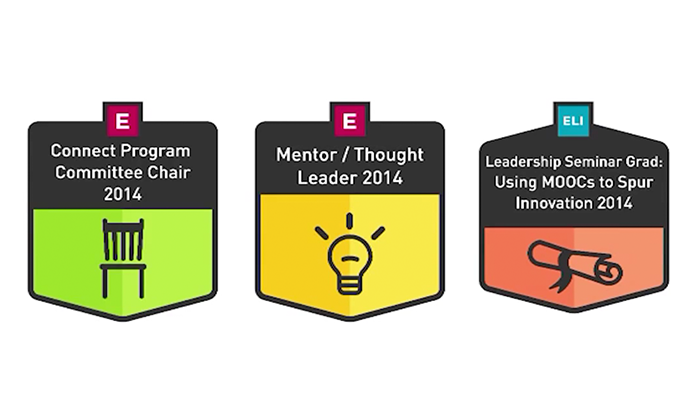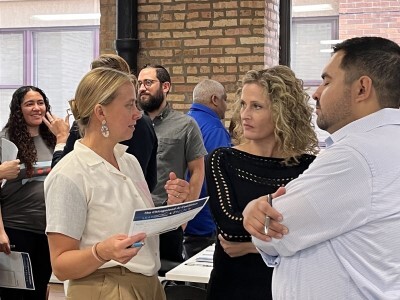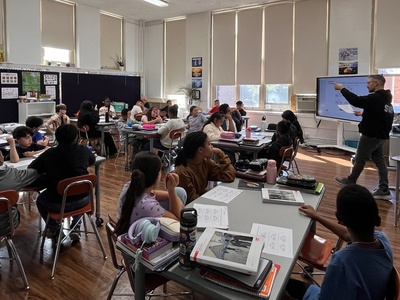Professional Learning
10 Lessons Learned from an Award-Winning Digital Badging Program
Topics

Educators are the lead learners in schools. If they are to enable powerful, authentic, deep learning among their students, they need to live that kind of learning and professional culture themselves. When everyone is part of that experiential through-line, that’s when next generation learning thrives.
Whether you are exploring digital badging or getting ready to launch your own initiative, these ten lessons will help you gain a better understanding of this emerging field.
This week, I was invited to give a talk on digital badging at the Association for the Advancement of Computing in Education’s (AACE) World Conference on Educational Media and Technology in Montréal, Quebec, Canada. (The conference had a significant amount of international participation.)
My presentation, Lessons Learned in Launching an Award-Winning Digital Badging Program, contains nuggets of wisdom that may be very helpful to your organization.
Whether you are exploring digital badging or getting ready to launch your own initiative, the ten lessons I shared are broadly applicable:
- Badge what you have. Rather than simultaneously trying to stand up new programming, products, or content to badge, focus first on what you do and what you have. Develop your foundational constellation based on existing opportunities, but structure it with flexibility to grow. The more you start with what you have, the less risk you assume up front. EDUCAUSE badging program is based on a strong professional development portfolio, including conference and events, leadership development programs, and online courses.
- Badge with partners if you can. Opportunities to develop badges need not be strictly internal to your organization. Consider partnerships and external opportunities that help meet program objectives. Keep in mind, of course, that your badge carries your brand. Your program must support your organizational mission.
It’s a balancing act, for sure. For example, the EDUCAUSE Learning Initiative co-branded a popular MOOC with the University of Central Florida on blended learning design that effectively serves both our mission for building the profession and our teaching and learning community. - Stack with care. Stacked (or layered) badges add weight to the constellation, both practically and usually also visually. You can tell at a glance that the stacked badge is different or somehow more significant. However, we also discovered stacking can be difficult to manage or confusing.
Early on we attempted a stacked badge based upon engaged participation in a series of loosely connected but thematically-aligned online courses. The community had difficulty following the connections over months of programming and the staff had difficulty tracking participants who met criteria. Our conclusion: this was not the best version of stacking!
On the other hand, stacking within an extended learning opportunity may prove motivational. In the ELI-UCF partnered MOOC, participants earn incremental badges from UCF for course assignments and activities. They may also elect to submit work accomplished over the course (along with an administrative fee) in application for an ELI-UCF Blended Learning Designer stacked badge. A successful comprehensive portfolio review process yields a more prestigious stacked badge. - Educate and communicate. These may seem all too obvious but it’s easy to underestimate either of these important elements.
Program planning must include a robust communication plan and concerted efforts to educate, both internally and externally, across time. Not everybody ‘gets’ badging. Depending upon target populations and internal resources, it can be a heavy lift yet it’s hard to imagine program success otherwise in these early days of digital badging.
We used nearly every channel at our disposal, including focus groups and advisory committees, surveys and polls, webinars, conference presentations, and publications. We developed an online resource library with curated resources.
We deployed a marketing plan and used social media to help the community get on board with badging. Communication and education efforts preceded the first badge issue by months, and continue today. - Design matters. There is infinite variety in the spectrum of badges. For digital badges to be meaningful, however, they must convey critical information at a glance. Badge real estate is very limited. Minimally, each badge should include 1) descriptive title and/or artwork to communicate the achievement, and 2) identify the issuing agency. You may be surprised if you do a quick search online just how many miss either or both of those two critical components. We also display the year of issue on our badges.
Professional graphic design is more than just a bonus; it immediately lends credibility and reinforces the brand each badge carries. Thoughtful design will ensure the constellation hangs together on launch while accommodating program growth and time to establish the program before a redesign becomes necessary. - Metadata matters. In setting up your constellation, you define each badge by description, criteria and evidence. When you click into a badge, you gain access to these details. Consistent language in metadata and parity in criteria and evidence across the constellation helps solidify the badge program, and underscores each badge’s meaning to recipients and those who aspire to earn them.
- Program planning is challenging—with or without the ice! (Remember the ice bucket challenge?) Badge program planning, which includes carefully considering stakeholders and engaging the target audience, is at least as important—and in many ways more difficult—than program execution and badge issue.
In launching the EDUCAUSE badge program, we relied heavily upon standard project management. We developed a project charter, a project plan, and utilized a highly functional team of stakeholders and consultants to plan, design, and develop the constellation and the program over six months leading up to our first badge issue. It was a lot of work, but the heaviest lift was in the planning. Executing the plan, by comparison, was easy! - Metrics are immature. The best metrics we now have are badge acceptance and display rates. However, they’re difficult to understand, in part because of the scarcity of comparative data and early evolution of the field. We also have badge activity data, but those figures are less useful as a metric for program success.
It’s important to keep in mind that badge program results are dependent upon education, communication, and marketing, all of which can vary across a program. Badge program assessment will improve with time and with more sophisticated reporting and data analytics. - Badge management is messy. Badging standards are not yet defined. All badges are not created equal, even within a single constellation, much less across the badging ecosystem. Badging platforms are not interoperable; there is no simple way to organize a public display of badges from disparate sources. However, the recently announced IMS Global Learning Consortium’s Digital Credentialing Initiative is a promising development on the badging frontier!
Meanwhile, some of your recipients may be stymied by what to do with their badge, especially early on. Once you’ve done your part in developing badges that communicate value, the onus for accepting, displaying and curating digital badges is on the earner.
Even those who are eager to earn badges may miss opportunities. How? The badge issue email may be caught by SPAM filters; they may never see it and therefore fail to accept it. (EDUCAUSE badge earners need only to log on to Credly to find it.) They may accept the badge but fail to display it publicly, on LinkedIn, Twitter, or in a digital portfolio. Or they may display it but fail to leverage it in performance review or a job interview. (See also lesson number 4!) - No badge take-backs. (Yet.) A badge is generally designed to be irretrievable. Our current system does not allow for badge take-backs. So if we make a mistake—perhaps a typo, we mostly have to live with it. However, we may request that a badge be deleted and we might then issue a new badge, if circumstances warrant. So let this serve as a cautionary note to dot your i’s and cross your t’s with care! I was relieved to learn recently that this element of badging is under careful review at Credly and, thankfully, subject to change soon.
So there you have it: ten lessons learned in launching our program. I hope you found them helpful!
The field of badging is a rapidly evolving ecosystem with exciting potential. Its relatively new status also presents challenges for early adopters. Yet our early experiences suggest that badging has tremendous potential to motivate, engage, and acknowledge achievements, accomplishments, and competencies.
If your organization is considering a digital badge program, I’d encourage you to read my first post in the series and to check out EDUCAUSE’s award-winning badging program. Badging onward!
(Also, here you can find online the full paper and presentation from which this post originated.)




